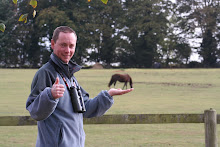And all the migrants disappear!
Sadly the wind direction changed overnight to the east and its amazing the effect it had. Yesterday, Higbee was heaving with birds but this morning it was dead! The change in direction provided ideal conditions for the birds to continue south. Very few warblers were about with 79 cedar waxwings the highlight.
Sadly the wind direction changed overnight to the east and its amazing the effect it had. Yesterday, Higbee was heaving with birds but this morning it was dead! The change in direction provided ideal conditions for the birds to continue south. Very few warblers were about with 79 cedar waxwings the highlight.
Yesterday we bumped into Richard Crossley who kindly invited to his house where there was some banding (ringing) happening in his garden. We were invited to drop in when we wanted so we decided to see what was happening today.
When we arrived Patti, the ringer in charge, was panicking slightly as she was on her own with a load of birds. We were put straight to work extracting gray catbirds. Probably about the same size at a song thrush and strangely soft in the hand. Sadly we had missed a couple of hummers earlier but we did get to ring several catbirds, red eyed and white eyed vireos, American redstart and common yellowthroat. Sadly an ovenbird managed to escape.
It is very interesting discussing the different ageing techniques especially as they don't seem to use moult much...
When we arrived Patti, the ringer in charge, was panicking slightly as she was on her own with a load of birds. We were put straight to work extracting gray catbirds. Probably about the same size at a song thrush and strangely soft in the hand. Sadly we had missed a couple of hummers earlier but we did get to ring several catbirds, red eyed and white eyed vireos, American redstart and common yellowthroat. Sadly an ovenbird managed to escape.
It is very interesting discussing the different ageing techniques especially as they don't seem to use moult much...
Things went quiet so with some advice from Richard we headed to explore the coast.
The main area we were looking at were the saltmarshes and beaches around Stone Harbour. The wind was getting pretty strong by now and the sand was a nightmare on the beach so we decided to do those another day.
We found the recommended place for a wader roost which held a nice selection of species. 102 willet, 1 marbled godwit, 1 grey plover, 16 greater yellowlegs, 5 least + 1 pec sand, 8 short billed dowitcher and a spotted sandpiper. Loads of herons and egrets were about feeding on the saltmarsh pools including 13 snowy & 7 great egrets, 4 tricoloured & 2 little blue herons and both species of night heron.
A little seawatch from apartment balcony at the end of the day saw a steady passage of gulls and terns with single gannet and Arctic skua new for the list. The most interesting thing was a turtle sp moving east offshore. I only ever saw the head but it was big!
The main area we were looking at were the saltmarshes and beaches around Stone Harbour. The wind was getting pretty strong by now and the sand was a nightmare on the beach so we decided to do those another day.
We found the recommended place for a wader roost which held a nice selection of species. 102 willet, 1 marbled godwit, 1 grey plover, 16 greater yellowlegs, 5 least + 1 pec sand, 8 short billed dowitcher and a spotted sandpiper. Loads of herons and egrets were about feeding on the saltmarsh pools including 13 snowy & 7 great egrets, 4 tricoloured & 2 little blue herons and both species of night heron.
A little seawatch from apartment balcony at the end of the day saw a steady passage of gulls and terns with single gannet and Arctic skua new for the list. The most interesting thing was a turtle sp moving east offshore. I only ever saw the head but it was big!

No comments:
Post a Comment